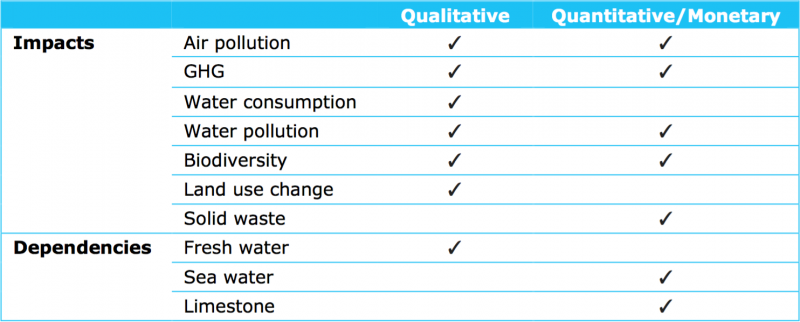
Tata Group is a multinational conglomerate holding company headquartered in Mumbai, India. The company includes 30 publicly listed Tata enterprises including Tata Steel, Tata Motors, Tata Consultancy Services, Tata Power, Tata Chemicals, Tata Global Beverages, Tata Teleservices, Titan, Tata Communications and Taj Group. These businesses collectively employ over 660,000 people and each operates independently under the guidance and supervision of its own board of directors and shareholders.
Tata decided to perform a natural capital assessment for a number of reasons which it saw as directly beneficial to its business:
In total, five Tata companies undertook a natural capital assessment:
In all cases the Value Chain focus was ‘direct operations’, and the Value Perspective adopted was ‘societal value’.
A number of different impacts and dependencies were assessed, with both qualitative and quantitative/monetary valuation methods being used to describe the final results. These are summarized in the following table:

Tata’s first attempt at a natural capital assessment was particularly helpful in making clear a number of challenges within the framework. The learnings will help make future assessments more robust.
In terms of data availability, Tata found that data – especially around biodiversity and land use, and land use change – is difficult to obtain. The company needed to rely heavily on proxy data, and contextual data around socio-economic performance was either found to be out of date or unavailable.
Tata also found that in terms of technical knowledge, the field of environmental and social impact assessment is still evolving. Some gaps still exist, for example the economic valuation of the benefits provided by particular landscape types. These include semi-arid and dessert ecosystems, impact assessment of ocean pollution, and the change in the course of river flow due to construction of hydroelectric dam infrastructure.
Finally, mainstreaming the outcome of a natural capital assessment continues to present challenges. Particularly, gaining internal buy-in to the process from influencers within the business such as COOs, CFOs and strategists. Taking informed business decisions based on natural capital valuation is still challenging since assumptions must be made around the applicability of valuation methods (such as value transfer) to each specific business context.
The next steps for Tata in their natural capital assessments are likely to involve driving internal buy-in further, and using some of the findings from the assessment process to good effect elsewhere within wider group operations.
One example of the former is in socializing Natural Capital concepts with Tata Board Members, C-suite and other influencers, and the creation of critical mass of Natural Capital ‘Champions’ among the Tata group companies. In terms of the latter, Tata are now trialing the use of an internal carbon price for the screening of CAPEX items, and in key operational decision making.
This case study was originally posted by the Natural Capital Coalition. For more information on the Protocol and to view more case studies, please visit their website.
Share this page: